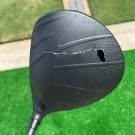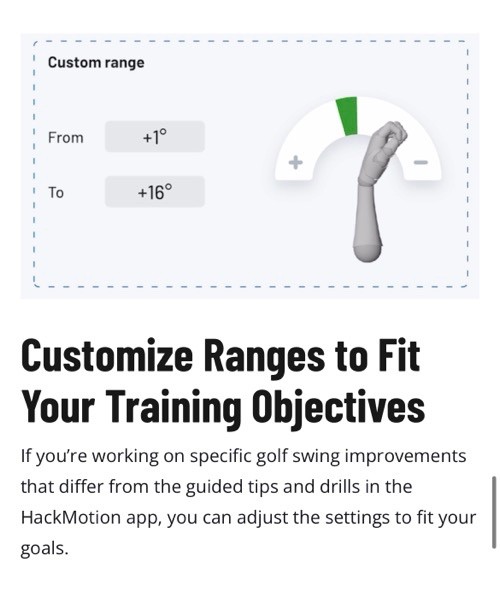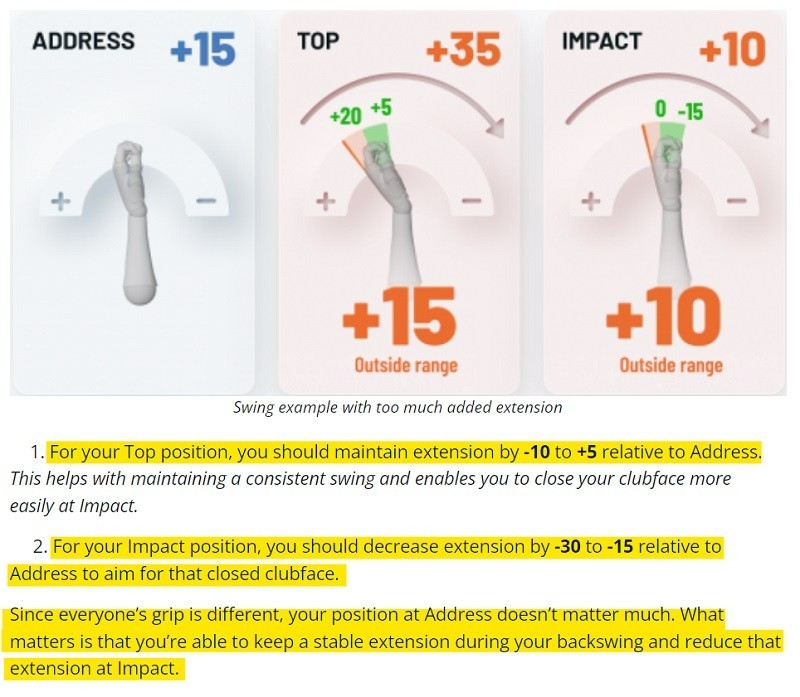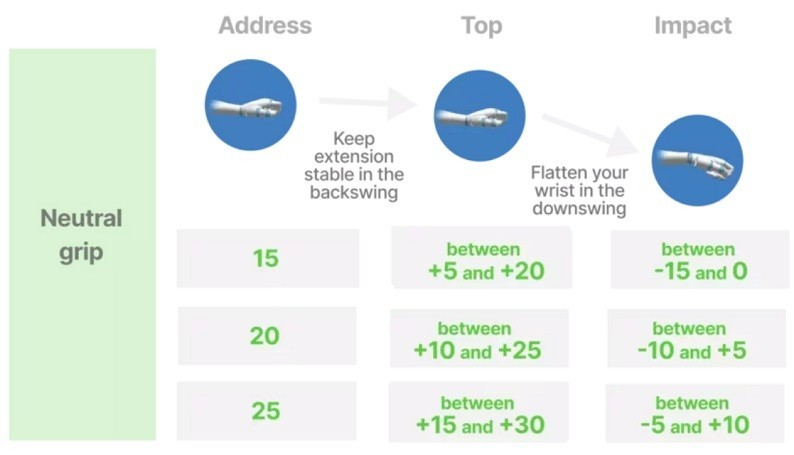-
Posts
1,037 -
Joined
-
Last visited
Content Type
Profiles
Forums
Articles
FAQ
Tests
Classifieds
Store
Group Buys
Everything posted by DriverBreaker
-

HackMotion Training System - 2023 Forum Review
DriverBreaker replied to GolfSpy_APH's topic in Forum Testing Reviews
Depends on the shot you are trying to hit (thus why I said if you are getting back to impact how you want for the shot you’re trying to hit). For a lower flight pitch shot, you might be more flexed or a 0* at impact. For a higher softer pitch, you might be more cupped. All depends on the shot intention. -

HackMotion Training System - 2023 Forum Review
DriverBreaker replied to GolfSpy_APH's topic in Forum Testing Reviews
I mean, there is “ideal” and then there is functional based upon your own anatomy, grip, etc. If you got to impact the way you needed to to hit the shot you were trying to hit and your contact was solid (not fat/thin), impact is king. The rational for having a more neutral position at the top would be to minimize timing needed in the downswing. But some people just can’t get comfortable or have the time available to practice a new position at the top, so you go with what they can do repeatedly and build off that. -

HackMotion Training System - 2023 Forum Review
DriverBreaker replied to GolfSpy_APH's topic in Forum Testing Reviews
I didn’t notice any differences in the readings. To be clear, we didn’t use the glove attachment. It was on the elastic band on his bare hand, then the glove over top of it. When I had the onboarding call with Martins, he said that would probably the better way, as the glove attachment could be funky if people readjust their glove strap each shot as like a trigger. -
Good to know!
-
@chisag what was the country where your box was made? I heard rumors there were two plants making them.
-

HackMotion Training System - 2023 Forum Review
DriverBreaker replied to GolfSpy_APH's topic in Forum Testing Reviews
I used the Hack Motion for the first time during a lesson setting today. Super fast to connect to my app, setup on the students arm/hand, etc. I briefly showed him how it worked and told him the data was mainly for me to get a baseline to move forward with. He thought it was cool but didn’t have many questions about it. Overall as a coach it was very useful data. I put it directly on his hand and then he put a glove on over top of it. -

HackMotion Training System - 2023 Forum Review
DriverBreaker replied to GolfSpy_APH's topic in Forum Testing Reviews
One thing that I really do appreciate about the Hack Motion product experience so far is just how much information they give the customer. They’re not trying to hide anything from you. It seems they really want you to understand the what and why of the product. I’m not sure if this is for us because we’re “Pro” owners, but there was a space on the website (I received it in an email from Hack Motion) where you can get a wrist mechanics course guide for free. Not sure if it is always free or not, but again, kudos to them for educating their users. I’ll see what the course entails and give thoughts on it once I get through it. -
Yeah, I might have to get a box next time I’m at Costco.
-
I had a box of these in my cart today at Costco but decided I couldn’t get them just yet… @GolfSpy_APH any word from HQ on when the ball lab for the V3 is coming?
-

HackMotion Training System - 2023 Forum Review
DriverBreaker replied to GolfSpy_APH's topic in Forum Testing Reviews
Played two separate nine hole rounds since working with the hack motion. I intentionally focused on adding a tiny amount of flexion at the top and through the downswing. Basically what would be “in range” while using the app. Ball flight with driver has been superb. Penetrating with my small fade. Same for irons. As a check point device for me to maintain my swing and decrease practice time, I think it will be excellent. I’ve got an initial assessment with a new client on Monday and I will be adding the Hack Motion to my assessment to get a baseline for him (along with other data). I imagine they data will be useful. -

HackMotion Training System - 2023 Forum Review
DriverBreaker replied to GolfSpy_APH's topic in Forum Testing Reviews
Played around with the full swing full analysis mode tonight. One of the hidden gems of this device is the tempo metric. John Novosel’s Tour Tempo research and book found that most Tour players have a 3:1 tempo with their swing. This device measures tempo, so you can tell if you’re getting quick or not. Very cool (bottom right of the image below). I also played around with the comparison feature just to see what that was like. I compared to the stable knuckles down release pattern (A). I try to be very minimal in my swing. I want as little change happening in the back and down swing. One thing I noticed that was very valuable was the radial deviation metric. I tend towards too much radial (cocking) in the backswing. It can cause me to lose the face during the swing. See image below: While my graph follows the same general path as the example, albeit it deviates due to differing starting positions, it did verify what I’m constantly working on at the top of the backswing (see image above). It is super helpful to have a device that gives you that immediate feedback vs having to look for it on video each time. The rotation and flexion/extension graph is what I would expect as well. Follows the same general shape with slight differences due to my stronger grip. Having lots of good fun with device so far. I also feel like I don’t have to practice as long. Each session so far has been basically a check-in to see if I’m getting those positive “dings” after each shot. As long as I’m in my ranges, I don’t need to really hit any more balls. More maintenance checks than anything. -

HackMotion Training System - 2023 Forum Review
DriverBreaker replied to GolfSpy_APH's topic in Forum Testing Reviews
Gotcha. I haven’t tried the full swing mode yet. As @cnosil and @Vegan_Golfer_PNW said, comparing to a pro in terms of the rotation number is potentially risky business. Flexibility, body type, swing direction, club path, shot shape they’re trying to hit, etc. all play a factor in how much rotation was captured on that shot that is being referenced. I’d look at your ball flight and use that as the determining factor in what you should be trying to do. That being said, as a thought experiment and/or as a fun learning activity, it could certainly be cool to see what a pro does and compare or try to feel that one time. I do think there is utility in that. It can show us what our bodies are capable of and limited in, which can help us build a more repeatable motion that we can personally can do. It might very well show that you shouldn’t be trying to emulate a certain pro. -

HackMotion Training System - 2023 Forum Review
DriverBreaker replied to GolfSpy_APH's topic in Forum Testing Reviews
I didn’t see that where it asks if you are happy with your address position. Was that in full swing analysis mode? -

HackMotion Training System - 2023 Forum Review
DriverBreaker replied to GolfSpy_APH's topic in Forum Testing Reviews
I get why they want to have you calibrate to zero (flat lead wrist straight to the elbow). That’s the reference point everything is built upon. Without the zero reference point, I’m not sure how it could feasibly calibrate. If it counts user’s address position as zero, then that could work. Is that what you’re saying? -

HackMotion Training System - 2023 Forum Review
DriverBreaker replied to GolfSpy_APH's topic in Forum Testing Reviews
Alright, my first short session with the Hack Motion sensor went off last night. Set up is insanely fast and literally takes less than 1 minute from the time you get the sensor on your wrist to hitting balls. You literally turn it on, open the app, calibrate and you’re off and running. I hit a few shots but felt the data wasn’t quite right. As I mentioned earlier, I have a very strong grip and the website gave a range of 30 - 40* extended at address. I was noticing that mine was only reading at 17-19* extended. This was causing the top of the swing and impact to be above the recommended range, even though I was consciously adding flexion at the top and on the way down. RPReplay_Final1688431074.mp4 You can see from the video above how the first 6 shots showed ranges almost half of what I was expecting at address. So I just recalibrated it in all of 15 seconds, double checked that a flat lead wrist was showing as zero degrees in the app (live real-time is so cool and useful) and then I got exactly what I expected. It does go to show, much like any piece of technology, that if you don’t get it setup and calibrated properly, your data will be off, and you could waste your time chasing numbers that are not accurate to begin with. If I hadn’t checked the calibration, I would’ve practiced way too much flexion in the downswing (for my strong grip). Then I would be pull hooking balls next time I played. The individual shot replay/analysis mode is insanely cool! This will likely be very valuable in my coaching, and you can email saved data from sessions to yourself or players and make notes on it. See video below: RPReplay_Final1688476138.mp4 There is so much more to explore with this device and I look forward to inspecting it all! -

HackMotion Training System - 2023 Forum Review
DriverBreaker replied to GolfSpy_APH's topic in Forum Testing Reviews
Onboarding call was solid overall. Martins was very cordial, professional, and helpful. He confirmed what I found online and said that the ranges are highly dependent on starting position and grip at address. Namely, the point is to return the wrist back to impact close to where you started and most need to lean toward more flexion (bowing) than they had at address to have a square face and a straight lead arm/shaft relationship at impact. I would agree, in general, as these are sound mechanics based on ball flight laws, principals of impact, leverage, efficiency, etc. He gave me a demo walkthrough of the setup, calibration, and navigation of the app. He answered some questions I had about best practices for use, who can get an on boarding call, and other minor things. I actually had to cut the call short to go give a lesson, but I was impressed with their desire to make sure users understand the process and app. I waited until I got home tonight to actually take my first swings with the Hack Motion. More to come on that over the next few days. But overall, it was extremely easy to set up, the app is very clean, and the unit connects to your phone/tablet extremely quickly. -

HackMotion Training System - 2023 Forum Review
DriverBreaker replied to GolfSpy_APH's topic in Forum Testing Reviews
I had a good onboarding call with Hack Motion this morning. Will write up a debrief of the call when I have some time later tonight perhaps. -

HackMotion Training System - 2023 Forum Review
DriverBreaker replied to GolfSpy_APH's topic in Forum Testing Reviews
Data overload is definitely a real phenomenon. Best practice would be to focus on one parameter per practice session. The brain can only feasibly focus with maximum effort on one thing at a time. Just ask my wife when she’s talking to me and I’m trying to multi-task. -

HackMotion Training System - 2023 Forum Review
DriverBreaker replied to GolfSpy_APH's topic in Forum Testing Reviews
Very valid point! This is what people tell me all they time once they come take lesson(s) from me. They waste much time practicing things that don’t actually translate to what they need. YouTube self-diagnosing. The main benefit of this, at least from a self-help standpoint, much like TrackMan etc., would be giving yourself baseline parameters to start with, then experiment with something to see cause/effect and then know if you are on the right track (ball flight can be king there). However, seeing someone like a coach and coming with that data would likely be a better long-term approach. Or potentially more efficient anyways. -

HackMotion Training System - 2023 Forum Review
DriverBreaker replied to GolfSpy_APH's topic in Forum Testing Reviews
-

HackMotion Training System - 2023 Forum Review
DriverBreaker replied to GolfSpy_APH's topic in Forum Testing Reviews
-

HackMotion Training System - 2023 Forum Review
DriverBreaker replied to GolfSpy_APH's topic in Forum Testing Reviews
So here is something I found on the Hack Motion website. Seems like yes, they do give you ranges based on strong, neutral, and weak grips. See images below. It seems like they utilize Coach Scott Cowx's interpretations and patterns heavily. -

HackMotion Training System - 2023 Forum Review
DriverBreaker replied to GolfSpy_APH's topic in Forum Testing Reviews
Yeah lots of strong grip players play fades. See it on Tour. For me, I just set it, then don’t consciously have any rotation of the clubface in the back and downswing. Pure body rotation. Works well enough. Of course feel/real can be different, so I’m really interested to see how this goes. -

HackMotion Training System - 2023 Forum Review
DriverBreaker replied to GolfSpy_APH's topic in Forum Testing Reviews
This is a big question I have as well. I have a very “strong” grip, so my wrist movement to square the clubface is different from someone with a “weak” grip. That’s a question I’ll be asking during the onboarding. -

HackMotion Training System - 2023 Forum Review
DriverBreaker replied to GolfSpy_APH's topic in Forum Testing Reviews
Package arrived today! I’ve got my onboarding call on Monday.















